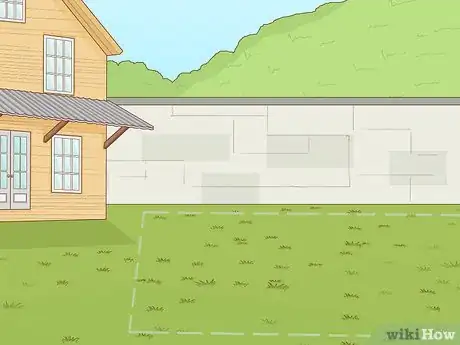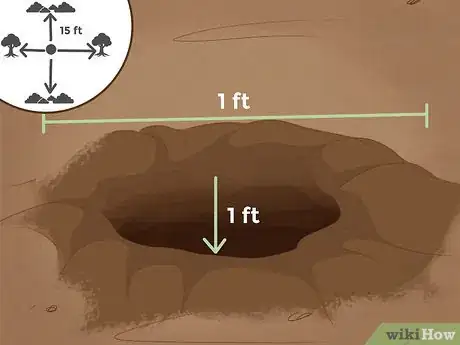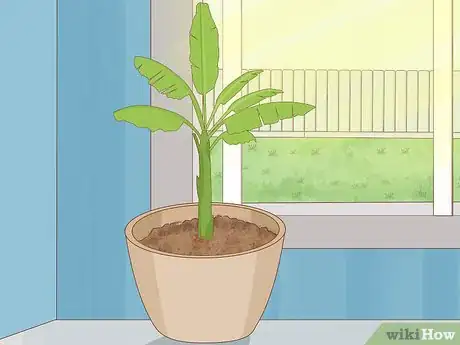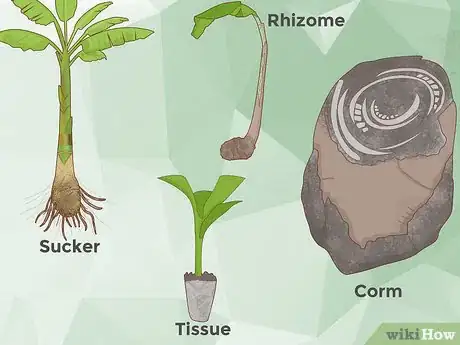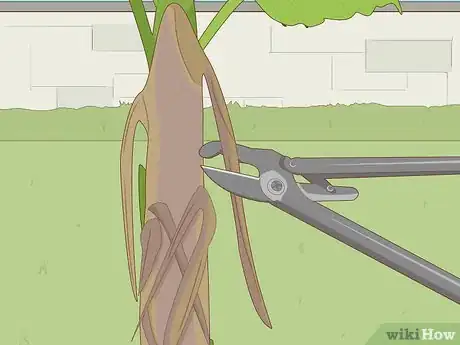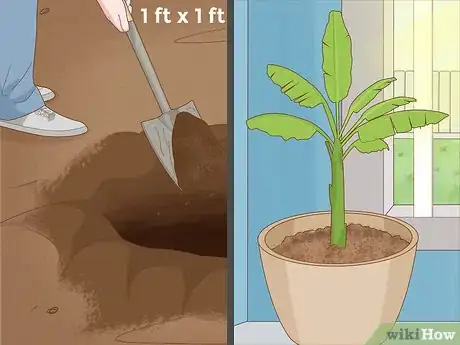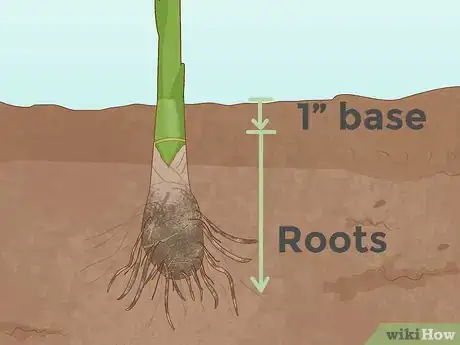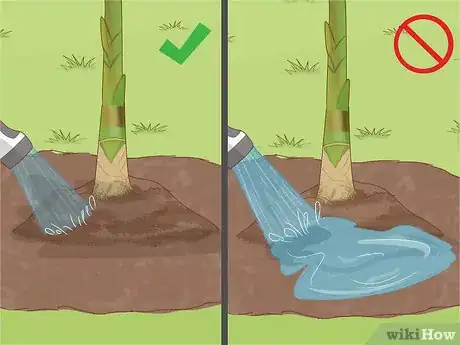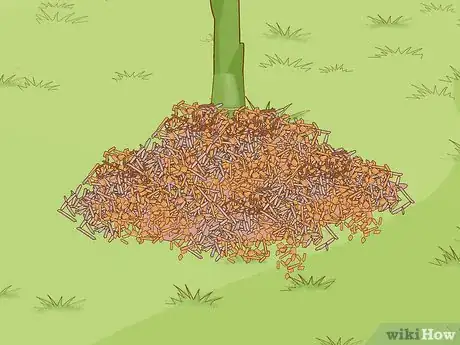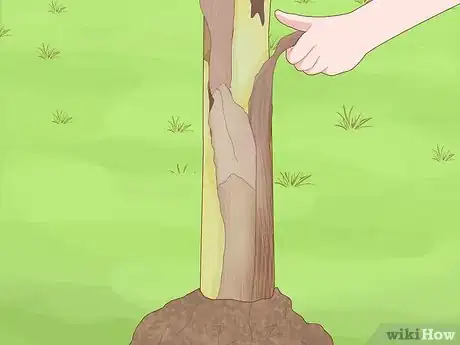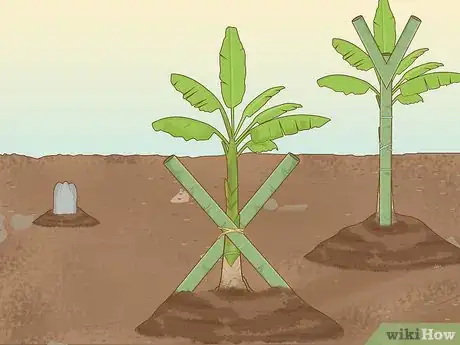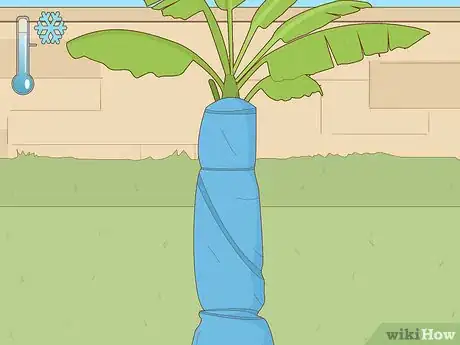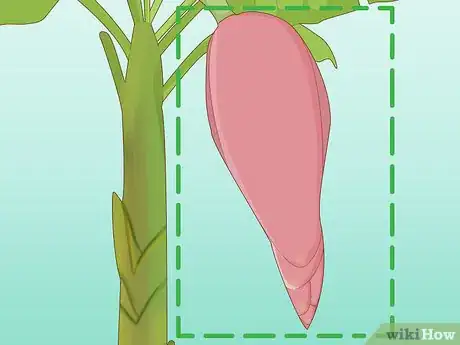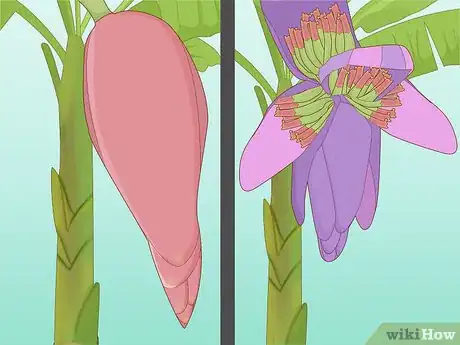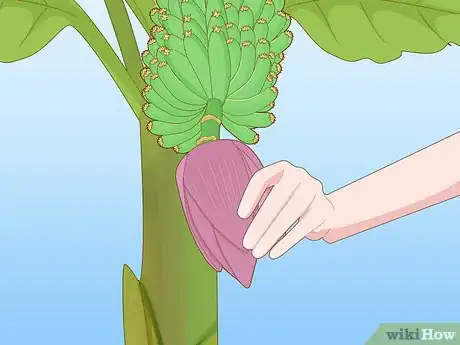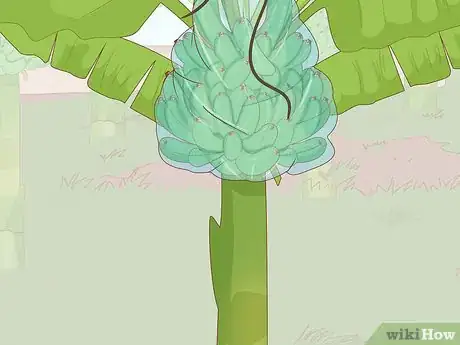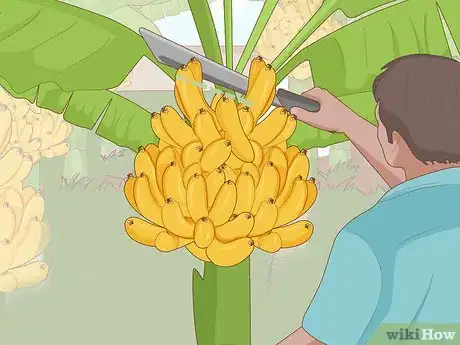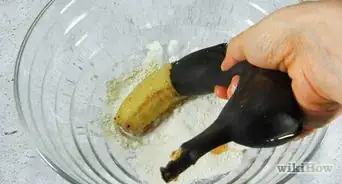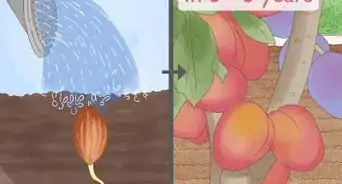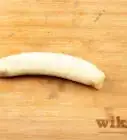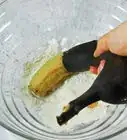This article was co-authored by Maggie Moran. Maggie Moran is a Professional Gardener in Pennsylvania.
There are 7 references cited in this article, which can be found at the bottom of the page.
wikiHow marks an article as reader-approved once it receives enough positive feedback. This article received 43 testimonials and 86% of readers who voted found it helpful, earning it our reader-approved status.
This article has been viewed 1,453,086 times.
Having your own access to delicious, healthy bananas can be wonderful if you're prepared for an extensive growing period. If you live in a warm climate or have a good indoor growing location, read on to learn about the yearlong journey of banana plant gardening.
Steps
Selecting a Planting Site
-
1Look up your area's temperature and humidity. Humidity should be at least 50% and as constant as possible. Ideal daytime temperatures are between 26–30ºC (78–86ºF), with night temperatures no lower than 20ºC (67ºF).[1] Acceptable temperatures are warm and very rarely reach lower than 14ºC (57ºF) or higher than 34ºC (93ºF).[2]
- Bananas can take up to a year to produce fruit, so it's important to know what range of temperatures it will experience throughout the year.
- If the temperature falls below 14ºC (57ºF), your banana plants will simply stop growing.
- They die if they are exposed to frost (<0ºC or <30ºF).
-
2Find the sunniest area in your yard. Banana plants grow best with 12 hours of direct, bright sunlight each day. They can still grow with less (more slowly), but you should determine where in your yard receives the most sun.Advertisement
-
3Choose an area with good drainage. Bananas require a lot of water, but are prone to rotting if the water does not drain adequately.
- To test drainage, dig a hole 0.3m (1 ft.) deep, fill with water, and allow to drain. Refill once empty, then measure how much water is left after 1 hour. Approximately 7-15 cm water drainage per hour is ideal for banana plants.
- A raised garden bed or adding 20% perlite to the soil assists drainage.[3] [4]
- This is especially important if you are using a banana plant that does not yet have leaves, or had the leaves removed for shipping. Leaves help evaporate excess water.[5]
-
4Allow sufficient space. While banana plants are technically herbs, they are often mistaken for trees for a reason. Some varieties and individuals can reach 7.6 m (25ft.) in height, although you should check the source of your banana plant or local banana growers for a more accurate estimate for your locale and variety.
- Each banana plant requires a hole at least 30cm(1ft.) wide and 30cm (1ft.) deep. Larger holes should be used in areas of high wind (but will require more soil).
- Keep banana plants at least 4.5m(15ft) from trees and shrubs (not other banana plants) with large root systems that may compete with the bananas' water.[6]
- Multiple banana plants help each other maintain beneficial humidity and temperature levels, as long as they are planted at the correct distance. If you can, plant several plants in a clump with 2–3m(6.5–10ft.) between each one, or a large number of banana plants 3–5m(10–16ft.) from each other.[7]
- Dwarf varieties require less space.
-
5Consider growing it indoors. If your outdoor environment is inadequate, you'll need an indoor location with similar requirements (12 hours bright light and constant warm temperature and humidity).
- You'll need a large planting container sufficient for its adult size, or be willing to transplant the banana into a larger pot whenever necessary.
- Always use a pot with a drainage hole in a location where water can drain well.
- Consider a dwarf variety if you don't have sufficient indoor space.
- Use half the amount of fertilizer when growing a plant indoors, or cease entirely if you don't have room for a larger plant. (This may be suitable for a houseplant you don't intend to harvest fruit from.)
Planting the Banana Plant
-
1Select your planting material. You can acquire a banana sucker (small shoot from the base of a banana plant) from another grower or plant nursery, or buy one online. A banana rhizome or corm is the base from which suckers grow. Tissue cultures are produced in laboratories to create higher fruit yield. If you're transplanting a mature plant, prepare a hole appropriate to its size and have an assistant help you.
- The best suckers to use are 1.8-2.1m (6–7ft) in height and have thin, sword-shaped leaves, although smaller suckers should work well if the mother plant is healthy.[8] Big, round leaves are a sign that the sucker is trying to make up for a lack of adequate nutrition from the mother plant.[9]
- If the sucker is still attached to a mother plant, remove it by cutting forcefully downward with a clean shovel. Include a significant portion of the underground base (corm) and its attached roots.[10]
- A rhizome (corm) without notable suckers can be chopped into pieces. Each piece with a bud (proto-sucker) will grow into a banana plant, but this will take longer than using a sucker.
-
2Trim the plant. Cut off any dead, insect-eaten, rotting or discolored sections of the plant. If most of the plant is affected, dispose of it away from other plants and find another planting material.
- If using a sucker, remove all but a few centimeters (1–2 inches) of the roots. This will limit the chance of disease. You can also remove any leaves in excess of five and/or cut the top of the plant off with a slanting cut to increase the amount of sunlight that warms the soil for root growth and rot prevention.[11]
-
3Dig a hole for each plant. Remove any plants or weeds that are growing on the planting site, then dig a circular hole 30cm wide and 30 cm deep (1ft. x 1 ft.) A larger hole will provide greater support for the plant but require more soil.
- If planting indoors, instead use a planting pot this size or larger.
-
4Mostly fill the hole with loose, rich soil. Leave several centimeters (a few inches) of space at the top to encourage drainage.
- Do not use potting soil, nor your regular garden soil unless you are sure it is suitable. Soil mixes intended for cacti can produce good results,[12] or ask other growers of the same banana variety.
- The ideal soil acidity for bananas is between pH 5.5 and 7. Acidity pH 7.5 or higher can kill the plant.[13]
-
5Place the plant upright in the new soil. The leaves should be pointing upward and the soil should cover the roots and 1.5–2.5cm (0.5–1 inches) of the base. Tamp the soil down to keep it in place but don't pack too firmly.
Caring For Your Plant
-
1Fertilize monthly a short distance from the trunk. Use store bought fertilizer, compost, manure, or a mixture of these. Add fertilizer immediately after planting in an even ring around the banana plant and repeat at monthly intervals.
- Young plants require 0.1–0.2kg (0.25–0.5lbs) each month, rising to 0.7–0.9kg (1.5–2 lbs) for an adult plant. Increase gradually as your plant grows.
- If the temperature falls below 14ºC(57ºF) or if the banana plant hasn't grown since last month, skip the fertilization.[14]
- Fertilizers are usually labeled with three numbers (N-P-K) representing the amount of Nitrogen, Phosphorus (Potash), and Potassium. Bananas require very high amounts of Potassium, but the other nutrients are important as well. You can use a balanced fertilizer (three numbers roughly equal) or a fertilizer that addresses deficiencies in your soil.[15]
- Do not use manure produced in the last few weeks, as the heat it releases while decomposing can damage the plant.[16]
-
2Water frequently but avoid overwatering. Underwatering is a common cause of banana plant death, but overwatering can cause the roots to rot.[17]
- In warm growing weather without rain, you may need to water your plant daily, but only if the top 1.5–3 cm (0.5–1 in.) of soil is dry. Test with your finger before watering.
- Reduce the amount of water per session if the plant is sitting in water for long periods. (That can cause root rot).
- In cooler temperatures when the banana is barely growing, you may only need to water once every week or two. Remember to check soil moisture.
- Leaves help evaporate excess moisture, so be careful not to soak (just moisten) a young plant that has not yet grown leaves.[18]
- Water the ring of fertilizer as well to help it soak into the soil.
-
3Add mulch. Remove dead leaves and banana plants and chop them up to place around the live plants. Other yard waste and wood ash can also be added to return nutrients to the soil.
- Check the mulch regularly and remove any weeds that are growing. These can compete with the banana plant.
-
4Keep an eye out for discolorations, dying leaves, and pests. If diseased plants are discovered, identify and treat them immediately, or uproot them. Insect pests should also be controlled as soon as they are found. Nitrogen and potassium deficiencies are the two most common nutritional problems for bananas, so learn to recognize the signs.
- Signs of nitrogen (N) deficiency: very small or pale green leaves; reddish pink leaf sheathes; poor growth rate; small fruit bunches.[19]
- Signs of potassium (K) deficiency: rapid appearance of orange/yellow color on leaves followed by leaf death; small or broken leaves; delayed flowering; small fruit bunches.[20]
- Examples of major plant diseases include: Bacterial Wilt/Moko Disease; Panama Disease/Fusarium Wilt; Banana Bunchy Top; Blackhead/Root Rot/Toppling Disease; and Black Leaf Streak.
- Examples of major plant pests include: Corn Weevil; Banana Aphid; Mealy Bugs. Fruit pests include: Flower Thrips; Red Rust Thrips; and Scarring Weevil.
-
5De-sucker your plants. Once your plant is mature and has several suckers, remove all but one to improve fruit yield and plant health.
- Cut all but one sucker off at ground level and cover the exposed plant with soil. Repeat with a deeper cut if they grow back.
- The surviving sucker is called the follower and will replace the mother plant after it dies.
- Exceptionally healthy plants can support two followers.
-
6Support the plant to avoid toppling of the plant due to strong wind or bunch weight. There are 3 easy ways of doing it:
- Wire/Rope and Bottle Method: Cut off the bottom of a plastic bottle. Insert a very long wire/very strong twine through the mouth and bottom of the bottle. Crunch the bottle to make it bendable and soft. Prop up the banana stem on the bottle, and use the wire to pull the stem slightly more upright. Tie the write to a strong support.
- Single Bamboo Method: Use a 3m (10') long bamboo pole or other strong, durable material. Cut a piece of Y-shaped wood 10cm (4") thick and 60cm (2') wide. Let the stem rest on the middle of the "Y" and push the bamboo upwards a little bit so the stem is wedged into the "Y" tightly. Bury the other end of the bamboo (the base) deeply into the ground. Tamp very firmly.
- Double Bamboo Method: Use two 3m (10') long bamboo poles. On one end of the poles, tie them together with strong wire 30 cm (1') from the end. Open up the poles to form a letter "X". Let the stem rest on the short end, push upwards a little bit to create pressure, and bury the other ends of both poles. Tamp very firmly.
-
7Provide overwinter care. If temperature during winter months falls too low for your plant, there are several ways to care for it:[21]
- Cover the stem with a blanket or soil. If there is no frost and the plant is still small, this may be adequate protection until the temperature rises high enough for it to grow again.
- Store the plant inside. Uprooting the entire plant, removing the leaves, and store in moist sand in a heated indoor area. Do not water or fertilize; the plant will go dormant until you're ready to plant it outside again.
- Grow the plant inside. This will require a large pot with drainage hole. If you don't want to grow your banana too big for your pot, you may need to cease or reduce the fertilizer treatments.
- Salvage pieces to plant later. If frost or cold has killed most of your plant, chances are the suckers and corm at the base are still usable. Cut these away from the dead portion and store them in their own small pots to plant outside later.
Nurturing and Harvesting Fruit
-
1Wait for the purple flower to emerge. The typical banana plant flowers in 6-7 months under ideal conditions, but may take up to a year depending on the climate.
- Never remove the leaves around the flower, as they protect it from the sun.[22]
- Do not confuse this with the Banana Bunchy Top Virus. See Tips below.
-
2Wait for the petals to withdraw and reveal bananas. This may take an additional 2 months or longer.[23] Each connected cluster of bananas is called a "hand" and each individual banana, a "finger". The entire stem containing several hands is called a bunch.
-
3Once all bunches are revealed, remove the extra portions. The remaining flower bud and/or tiny extra banana hand are the sterile male portions of the plant. The hand should wither off on its own, but removing the flower bud will cause the plant to put more energy into growing fruit.
- The male portion of the flower is called the "banana heart". Some varieties of banana plants produce edible banana flowers that are popular in Southeast Asian cuisine, but not all are suitable for consumption. Most flowers will fall off and die before harvest.
- Use a stick to prop up the plant if the bunches are dragging it down.
-
4Cover the bunch with plastic covers. This will protect the fruit from insects and other dangers, but they must be open at both ends to allow adequate air and water flow.[24]
- Tie the nylon or plastic sack with soft twine several inches from the first hand.
-
5Harvest bananas when the flowers or plant are dying. The small flower at the tip of each banana will become dry and easily rub off, or the banana plant will lose most of its leaves. This is a good time to harvest the fruit.
- Cut a notch halfway into the tree, opposite the side of the bunch.
- Carefully let the tree bend and cut off the bunch.
- The fruit will ripen quickly once harvested, so you may want to pick some well in advance of harvesting so you don't end up with excess fruit that will go to waste.
-
6Cut the stem of the tree and prepare the next sucker. Remove the top half of the banana stem once you harvest the fruit. Desucker the base using the same process as you have while caring for your plant.
- Remember to leave one sucker to replace the now-dying mother plant.
Expert Q&A
Did you know you can get premium answers for this article?
Unlock premium answers by supporting wikiHow
-
QuestionCan you plant a banana tree from a banana?
 Maggie MoranMaggie Moran is a Professional Gardener in Pennsylvania.
Maggie MoranMaggie Moran is a Professional Gardener in Pennsylvania.
Home & Garden Specialist
-
QuestionHow long does it take for a banana tree to bear fruit?
 Maggie MoranMaggie Moran is a Professional Gardener in Pennsylvania.
Maggie MoranMaggie Moran is a Professional Gardener in Pennsylvania.
Home & Garden Specialist
-
QuestionDo all banana trees grow bananas?
 Maggie MoranMaggie Moran is a Professional Gardener in Pennsylvania.
Maggie MoranMaggie Moran is a Professional Gardener in Pennsylvania.
Home & Garden Specialist
Things You'll Need
- Banana plant (sucker, rhizome/corm, tissue culture, or full plant to transplant)
- Adequate indoor or outdoor environment (see instructions)
- Rich, dark, fertile soil
- Balanced fertilizer and/or manure & wood ash (large amounts)
- Large amounts of water
- Shovel
- Large knife
Warnings
- Wear old clothes before cutting any part of the banana plant because the sap causes black patches that are very hard to wash out.⧼thumbs_response⧽
- Avoid taking and planting diseased plants from diseased mother plants.⧼thumbs_response⧽
- In areas where Banana Bunchy Top exists, do not share banana suckers with friends. Only buy plants from retailers who can assure the plant is disease-free. It may not be obvious that a plant has Banana Bunchy Top so ensure you don't share plants.⧼thumbs_response⧽
References
- ↑ http://www.tropicalpermaculture.com/growing-bananas.html
- ↑ http://www.tropicalpermaculture.com/growing-bananas.html
- ↑ http://www.bananaplants.net/banananinfo.html
- ↑ http://www.gardeningchannel.com/how-to-grow-your-own-banana-plant-or-banana-tree/
- ↑ http://www.tropicalpermaculture.com/growing-bananas.html
- ↑ https://www.youtube.com/watch?v=K6XEOOPLYIE
- ↑ http://www.tropicalpermaculture.com/growing-bananas.html
- ↑ http://www.iita.org/c/document_library/get_file?uuid=961e89b0-1827-43f5-bc8c-3f3fdf04ec10&groupId=25357
- ↑ http://www.tropicalpermaculture.com/growing-bananas.html
- ↑ http://www.tropicalpermaculture.com/growing-bananas.html
- ↑ http://www.iita.org/c/document_library/get_file?uuid=961e89b0-1827-43f5-bc8c-3f3fdf04ec10&groupId=25357
- ↑ http://www.gardeningchannel.com/how-to-grow-your-own-banana-plant-or-banana-tree/
- ↑ http://homeguides.sfgate.com/ingredients-soil-banana-trees-57409.html
- ↑ http://www.bananaplants.net/banananinfo.html
- ↑ http://www.bananaplants.net/banananinfo.html
- ↑ http://www.iita.org/c/document_library/get_file?uuid=961e89b0-1827-43f5-bc8c-3f3fdf04ec10&groupId=25357
- ↑ http://www.tropicalpermaculture.com/growing-bananas.html
- ↑ http://www.tropicalpermaculture.com/growing-bananas.html
- ↑ http://www.iita.org/c/document_library/get_file?uuid=961e89b0-1827-43f5-bc8c-3f3fdf04ec10&groupId=25357
- ↑ http://www.iita.org/c/document_library/get_file?uuid=961e89b0-1827-43f5-bc8c-3f3fdf04ec10&groupId=25357
- ↑ http://www.bananaplants.net/banananinfo.html
- ↑ http://www.tropicalpermaculture.com/growing-bananas.html
- ↑ http://www.tropicalpermaculture.com/growing-bananas.html
- ↑ http://www.tropicalpermaculture.com/growing-bananas.html
- ↑ http://www.ebi.ac.uk/2can/genomes/viruses/Banana_bunchy_top_virus.html
- ↑ http://www.tropicalpermaculture.com/growing-bananas.html
About This Article
To grow banana plants, plant a few banana suckers in a sunny spot with well-draining soil. Water the suckers whenever the top few inches of soil are dry and fertilize them monthly with a balanced fertilizer so they grow healthy and strong. Once your plants are mature, use bamboo poles to help support them so they don't fall over. If you live somewhere with cold winters, move your banana plants inside or cover their stems with mounds of soil to protect them from the cold. To learn more from our Horticulturist co-author, such as ideal planting conditions or how to harvest fruit, keep reading the article!

